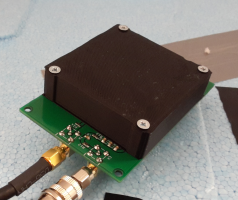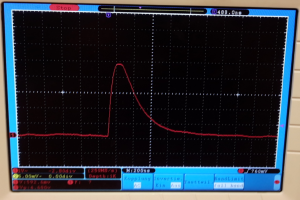Charge Measurement on upcoming Muon Detectors - Motivation
Our currently working detector prototype has one big flaw over the new upcoming one: It’s counting pulses from a Silicon Photomultiplier (SiPM), generated by ionizing radiation hitting an scintillator, that we define as ‘high enough’.
What is ‘high enough’?
Since the detector is using a BC-408 scintillator it should be able to detect
every kind of charged particles, X-rays (< 100 keV), alphas and betas.
And that’s why i am currently designing a charge measurement for the new detector series.
The basic principle behind this is the same as it is used in scintillation counters:
The amount of light that is emitted during the scintillation process is dependent on the particles (radiation) energy.
The amount of photocurrent the SiPM is generating in turn depends on the number of detected photons.
So measuring the total amount of phtocurrent over the time of an event (this is acually the charge) will give us a number that is somehow related an particles energy.
It’s a spectroscopy of the detected radiation in the end.
With knowlege about energy levels, that are going to be expected, one could then identify the muons between all the other stuff.
Basics about SiPMs:
The silicon photomultiplier: fundamentals and applications of a modern solid-state photon detector
What to consider working with plastic scintillators:
On the design of experiments based on plastic scintillators using Geant4 simulations
What to expect from Muons on the Earth’s surface:
Terrestrial Muon Flux Measurement at Low Energies for Soft Error Studies

